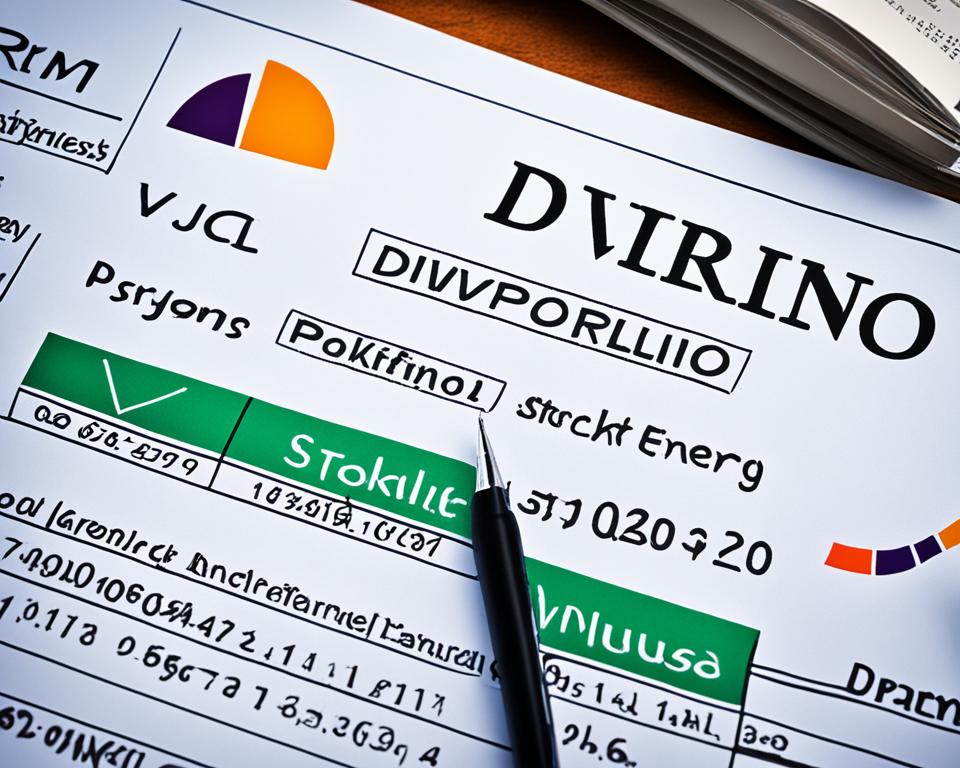For individuals pursuing a robust dividend investing strategy, Dividend Reinvestment Plans, commonly known as DRIPs, stand out as a powerful tool. These programs enable the automatic reinvestment of stock dividends, offering investors a streamlined path to acquire additional shares of a company. In the United States, where astute financial planning is highly valued, utilizing DRIPs can complement an investment strategy by leveraging the cyclic nature of dividends and the allure of compounding growth.
DRIPs present shareholders with a unique opportunity to reinvest their cash dividends on the payment date directly into more shares or fractional shares. This process caters not only to their desire for an incremental but steady expansion of their shareholdings but also to their financial acumen in recognizing the long-term benefits of compounded returns. Indeed, many investors appreciate that this method circumvents additional fees typically associated with stock purchases on the open market, making dividend reinvestment plans an efficient choice for growing one’s investment portfolio.
Moreover, the popularity of DRIPs is evident, with a considerable number of publicly traded companies—approximately 650—and closed-end funds—around 500—currently offering these plans. This demonstrates a clear recognition within the investment community of the distinct advantages that DRIPs bring to the table.
Key Takeaways
- DRIPs afford investors a method for reinvesting stock dividends directly into additional shares, fostering growth in their portfolios.
- These plans are essential components of a dividend investing strategy, offering both automatic reinvestment and the potential for compounded returns.
- Investors can capitalize on DRIPs to avoid common brokerage commissions and sometimes secure shares at a discounted rate.
- With the prevalence of DRIP options across numerous publicly traded companies and closed-end funds, they are a widely accessible investment choice.
- DRIPs benefit all parties involved, supplying companies with additional capital while providing investors with cost-effective investment expansion.
Understanding Dividend Reinvestment Plans
At the core of a savvy investing strategy, Dividend Reinvestment Programs (DRIPs) offer a strategic pathway for investors to magnify their holdings through the power of compound returns. These plans embody the principles of prudent investing, providing mechanisms that entail automatic reinvestment of dividends to purchase additional stock, thereby harnessing the long-term benefits of compound growth. As a centerpiece in the arsenal of seasoned investors, DRIPs stand out as a low-cost, efficient method to incrementally enhance one’s portfolio.
Commission-Free Acquisitions & Discounts: One of the main attractions of dividend reinvestment programs is their cost-effectiveness. By eliminating brokerage commissions and offering share purchases at a discount—usually between 1% to 10% below the market value—DRIPs create a favorable environment for investors to grow their stakes in a company at a more accessible cost basis. This accessibility enables both seasoned and novice investors alike to make the most of their dividend income.
- The absence of brokerage commissions removes a traditional barrier to entry, making it easier for shareholders to increase their investment over time.
- Discounted share prices through DRIPs act as a catalyst for compounding, multiplying the benefit for investors as they reinvest dividends.
Tax Implications: The fiscal efficiency of DRIPs continues to be a topic of consideration for investors. While dividends reinvested through these programs are still recognized as taxable income, they bypass the immediate cash payout. It’s essential for investors to understand that even though these dividends are put directly back into purchasing shares, they must be reported to tax authorities, unless ensconced within a tax-advantaged vehicle like an IRA.
The Cycle of Reinvestment: The defining feature of DRIPs lies in the cycle of reinvestment they perpetuate. As shareholders use dividends to procure additional shares, this incremental increase in share count not only enhances their equity stake but also sets the stage for receiving larger dividends in the future. Thus, with each reinvestment, the shareholder’s potential returns could swell substantially over time, illustrating the essence of an intelligent investing strategy geared towards sustained growth.
| Feature | Benefit |
|---|---|
| Automatic Reinvestment | Convenience and consistency in growing investments |
| Lower Cost Basis | Increased financial gains due to reduced purchase price |
| Discounted Shares | Immediate value addition due to below-market pricing |
| Taxable Income Handling | Opportunity for tax planning, especially with tax-advantaged accounts |
| Compounding Returns | Exponential growth potential over the long term |
DRIPs ensure that the maxim ‘time in the market beats timing the market’ holds true, as these programs entrench the wisdom of continuous investment. In summary, DRIPs function as an indispensable element of a comprehensive investing strategy, offering a methodical approach to reinvesting dividends for amplified financial rewards.
The Mechanics of DRIPs: How They Work
The architecture of Dividend Reinvestment Plans or DRIPs is elegantly designed to optimize investment growth by facilitating the automatic reinvestment of dividend payments into additional shares. A crucial cog in the wheel of an investment strategy, DRIPs smoothen the path toward accumulating more dividend stocks effortlessly and systematically. In essence, they allow dividends, which are reflections of a company’s profitability, to directly beget more dividends, perpetuating a cycle of wealth multiplication.
With DRIP investing, the manual process of reinvestment ceases to exist. When dividends are declared, instead of finding their way to the investor’s bank account or arriving as a cheque in the mail, these funds are funneled directly back into the purchase of the company’s stock. This seamless automatic reinvestment process harmonizes with the investor’s ambition of not just holding shares but steadily increasing their stake in the company over time.
Automatic Reinvestment Process
DRIPs are ingeniously set up to automatically reinvest cash dividends into the purchase of stock. This automation eliminates the need for any action on the day of the dividend payment, ensuring that no dividend payment is ever missed and every opportunity for investment growth is capitalized upon. It strengthens the investor’s position in dividend stocks without them lifting a finger.
Acquisition of Additional Shares
Through DRIPs, shareholders can acquire additional shares or fractional shares directly from their company, most often at no extra cost. Some programs even afford participants the ability to buy shares at a price discounted below market value, promoting a stock purchase that is immediately beneficial to the shareholder’s portfolio. Every dividend reinvestment brings additional shares, incrementally increasing the investor’s ownership in the company.
Fractional Shares and Their Benefits
The utility of fractional shares cannot be overstressed in the context of DRIPs. This feature ensures the full dividend amount is utilized to acquire equity, down to the last cent. Although individual dividends may not always round up to the purchase price of a single full share, DRIPs permit the possession of fractional shares, so none of the dividend reinvestment value is left idle. The cumulative effect of acquiring these fractional shares can be profound, offering a tangible boost in investment growth and the actualization of DRIP benefits over the long term.
| DRIP Feature | Investor Benefit |
|---|---|
| Automatic Reinvestment | Facilitates hands-off portfolio growth and ensures all dividends are reinvested |
| Additional Share Acquisition | Strengthens shareholding and ownership in the company |
| Fractional Shares | Maximizes investment utilization and increases share count precisely |
| Commission-Free Purchases | Saves on transaction costs, maximizes returns |
| Discounted Shares | Provides instant equity value, enhances investment attractiveness |
Advantages of DRIPs for Investors
Investing through Dividend Reinvestment Plans (DRIPs) presents a suite of benefits that can significantly augment an investor’s journey towards financial growth. These advantages not only facilitate a more economical approach to share accumulation but also leverage the compelling effects of compounding to accelerate long-term investment gains. Here’s how these programs reinforce a strategic portfolio expansion.
Commission-Free Share Accumulation
One of the principal benefits of DRIP programs lies in their commission-free structure. Unlike typical stock market transactions that incur trading fees, DRIPs allow shareholders to expand their holdings within a company without the additional financial burden of commissions. This cost-saving aspect is a cornerstone of investment savings and enables a consistent increment in share ownership, which is particularly beneficial during the compounding stage of asset growth.
Access to Share Price Discounts
DRIPs often entice participants with the added perk of share price discounts. This means that investors can potentially purchase shares at a price that is less than the current market value, typically ranging from 1% to 10% off. Such discounts lower the cost basis of the investment, creating financial growth opportunities and providing a tangible incentive for shareholders to remain invested in the company’s future success.
Compounding Returns Over Time
At the heart of DRIP advantages is the innate ability of these plans to foster the compounding of returns. As dividends are reinvested to acquire more shares, those shares yield further dividends, which are then also reinvested, creating a cycle that is at the core of any successful long-term investment strategy. This iterative process can significantly amplify an investor’s portfolio value over extended periods, underscoring the potent financial benefits inherent in DRIP participation.
In essence, DRIPs provide an accessible route to share accumulation with notable investment savings and the essential benefit of compounding returns. These programs are a testament to the practicality and strategic foresight offered by DRIPs, positioning them as a valuable, growth-oriented component of investment planning.
The Significance of DRIPs for Dividend Growth
Dividend Reinvestment Plans (DRIPs) have emerged as a key element in many investment strategies, particularly for those seeking sustainable dividend growth. The intrinsic value of DRIPs goes beyond mere convenience, as it taps into the power of compounding, which can be a game-changer for long-term wealth creation. Their significance is deeply rooted in the notion that every reinvested dividend works to increase the shareholder’s overall payout potential, positioning DRIPs as a beacon for those looking to build and fortify their investment portfolios.

Investors who choose to reinvest dividends through DRIPs are often able to capitalize on three main benefits: share accumulation without commission fees, potential to purchase shares at a discounted rate, and the compounding effect of reinvestment. This trio forms a strategic foundation that can propel dividend earnings to greater heights, especially when aligned with a company’s inclination to incrementally boost dividend offerings over time.
The following table provides a clear depiction of how DRIPs are a vital mechanism for achieving dividend growth:
| DRIP Feature | Contribution to Dividend Growth | Strategic Benefit for Investors |
|---|---|---|
| Commission-Free Reinvestment | Increased number of shares over time with reduced costs | Maximized reinvestment value, leading to larger future payouts |
| Discounted Share Prices | Lower purchase cost allows for greater quantity of shares | Immediate value and upside potential from market discrepancies |
| Compounding Effect | Reinvested dividends earn dividends themselves, expanding share count | Accelerated portfolio growth with each passing dividend cycle |
In the realm of investment strategies, DRIPs serve as a vital tool for those aiming for consistent dividend growth. As dividends are reinvested, shareholders accumulate more shares, and even slight increases in a company’s dividend can significantly amplify the returns due to the expanded volume of shares. Over time, this translates into a robust dividend portfolio, underscored by the meticulous and strategic reinvestment endowed by DRIPs. Thus, the colloquial investor wisdom ‘buy and hold’ is taken to new heights through the judicious use of DRIPs, imbuing portfolios with the potential for steady and ongoing expansion.
Company Benefits of Offering DRIPs
While individual investors are typically the focus when discussing Dividend Reinvestment Plans (DRIPs), the benefits these plans extend to companies are equally significant. Firms that deploy DRIP offerings experience advantageous financial and strategic rewards, both in terms of capital generation and fostering a supportive investor base.
Enhanced Capital Generation
The initiation of DRIP plans is a powerful tool in a company’s arsenal for capital generation. The funds that might otherwise be disbursed as cash dividends are instead channeled back into the firm, allowing for reinvestment in key areas of business development and operational expansion. This reinvestment leads not just to financial solvency but also paves the way for future innovation and growth. DRIPs constitute a strategic form of securing additional funds without resorting to the complexities of new equity offerings or incurring debt.
Cultivation of Long-Term Shareholders
A crucial advantage for any publicly-traded entity is the cultivation of long-term shareholders, which DRIPs effectively promote. Investors who enroll in DRIP offerings tend to exhibit noteworthy investor loyalty, often opting to stick with their investments even during market fluctuations. This static, steadfast shareholder base grants companies a certain measure of stability, which can be especially valuable in volatile periods. Furthermore, the establishment of a consistent, long-term investor pool through DRIP plans can elevate a company’s prestige and investor appeal in the marketplace.
| DRIP Impact | Company Advantages |
|---|---|
| Increased Capital | Reinvestment into the company rather than dividend payouts |
| Shareholder Stability | Lower volatility in stock holdings and persistent capital support |
| Market Perception | Enhanced company reputation through visible long-term backing |
| Investor Loyalty | Cultivation of dedicated stakeholders with longevity |
It’s evident that when companies facilitate DRIP offerings, the outcomes extend well beyond mere financial transactions. Not only do they create environments ripe for capital generation, which they can harness for progressive endeavors, but they also establish valuable, long-term relationships with shareholders who are more likely to invest in the journey as well as the results.
Real-World Examples of DRIP Offerings
Exploring DRIP examples in the current investment landscape reveals how these reinvestment schemes are applied in real-world applications. Companies across diverse sectors have implemented DRIPs, highlighting their adaptability and potential for increasing shareholder value. A notable DRIP case study is that of 3M, a multinational conglomerate corporation known for its innovation and product diversity.
3M’s DRIP program is emblematic of how these offerings are structured to benefit both the company and its investors. Shareholders of 3M can automatically reinvest their cash dividends into additional shares of the company, enhancing their investment without incurring the fees typically charged in open market transactions. Moreover, 3M embodies the investor-friendly approach of DRIPs by covering all fees and commissions, thereby removing a barrier that might deter shareholders from participating.
While the 3M example stands out, many other companies have recognized the value of offering DRIPs to their investors. These plans often encourage long-term investment strategies and can build a reliable shareholder base committed to the company’s growth and success. To illustrate the variety and operation of DRIPs, we present a table capturing the features of different DRIP offerings:
| Company | DRIP Feature | Investor Benefit |
|---|---|---|
| 3M | No fees or commissions | Reduces cost of share accumulation |
| ExxonMobil | Optional cash investments | Adds flexibility for additional share purchasing |
| Johnson & Johnson | Discount on reinvestment | Provides shares at below-market prices |
| Coca-Cola | Fractional share buying | Ensures full use of dividends for share acquisition |
These DRIP offerings underscore a key facet of these plans: to foster shareholder commitment and financial participation. For investors looking to expand their portfolio with reinvestments that compound over time, examining such DRIP case studies can provide valuable insights.
As these real-world applications demonstrate, DRIPs are versatile tools that can align with various investor goals. Understanding how companies like 3M manage their DRIPs allows investors to make informed decisions on which plans best suit their financial strategies. Whether the aim is to minimize investment costs, enhance share accumulation, or capitalize on discounted share prices, DRIPs are potent channels through which shareholders can realize their long-term investment objectives.
Types of Dividend Reinvestment Programs
Dividend Reinvestment Plans (DRIPs) come in various forms, offering tailored solutions for investors based on their unique needs and preferences. These plans are essential components in the strategy of investors who are focused on compounding their wealth through reinvestment of dividends. Let’s explore the different DRIP models and how they fit into the broader investment landscape.
Company-Operated Plans
Company-operated DRIPs are managed internally by the issuing entities, often utilizing dedicated departments for their administration. This model allows for a high degree of internal management and direct engagement with shareholders. Companies that adopt this approach can tailor program characteristics to align with their strategic objectives, fostering a closer relationship with their investors.
Third Party-Operated DRIPs Versus Broker-Operated Systems
On the other side of the spectrum, third-party DRIPs are managed by external agencies. This outsourcing can be a cost-effective investment option for companies by streamlining operations without burdening internal resources. Conversely, broker-operated DRIPs provide an avenue for investors whose companies do not offer their own DRIPs. Brokers carry out the purchase of shares on the open market, oftentimes at low or no commission, adding a layer of convenience for the client.
Characteristic Comparison of DRIP Types
Each type of DRIP has its own set of advantages and program characteristics that appeal to different investment preferences. A comparison of company-operated, third-party, and broker-operated DRIPs highlights significant investment differences and may help investors decide which DRIP models suit their financial goals best. To illustrate this, let’s delve into the particulars of each plan type.
| DRIP Type | Management Style | Investor Engagement Level | Typical Cost to Investor | Convenience |
|---|---|---|---|---|
| Company-operated DRIPs | Internal management by the company | Direct shareholder engagement | Low or no fees | Varies by company policy |
| Third-party DRIPs | External management by a specialized agency | Indirect, through third-party services | Potentially includes service fees | Dependent on third-party efficiency |
| Broker-operated DRIPs | Management by brokerage firms | Handled through brokerage services | May be commission-free | High, with potential online platforms |
A comprehensive DRIP comparison, detailing each plan’s investment options and the potential impact on shareholder returns, is crucial for the investor looking to make an informed decision. Whether prioritizing control, cost-effectiveness, or convenience, there is a DRIP to match each investor’s strategy, be it through company-operated DRIPs, third-party systems, or broker-operated DRIPs.
Quantifying DRIP Impact: An Investment Scenario
Understanding the real-world impact of Dividend Reinvestment Plans (DRIPs) can best be displayed through practical investment scenarios. DRIP impact analysis forms an integral part of financial modeling, helping investors grasp the quantitative benefits these plans can bring to their portfolios. Consider the case of a Real Estate Investment Trust (REIT) that presents a DRIP with a 15% discount on share purchases.
In this scenario, an investor named Mary, who owns 1,000 shares of the REIT, opts to reinvest the cash dividends through the DRIP. The REIT has declared a dividend of $10 per share, and on the date of dividend payment, the market price of each share is $100. Due to the 15% DRIP discount, Mary can purchase additional shares at $85 each, rather than the current market price.
With such a strategic move, Mary’s $10,000 in cash dividends (1,000 shares x $10 dividend) can now secure her an additional 117 shares (exact calculation: $10,000 / $85 per share). The inclusion of fractional shares, which will be carried over to the next dividend payment, introduces precision into this long-term growth strategy, reflecting DRIP’s capacity to reinvest dividends down to the last cent.

By leveraging the discounted reinvestment option, Mary not only maximizes her dividend utility but also substantially grows her stake in the REIT, harnessing the potential for compounded dividends in future payout cycles. This quantitative perspective underscores the tangible financial advantages afforded by DRIP participation—a highlight in investment strategy discussions.
| Investment Details | Pre-DRIP | Post-DRIP |
|---|---|---|
| Number of Shares Owned | 1,000 | 1,117 |
| Total Dividend Payout | $10,000 | Reinvested |
| Share Purchase Price with DRIP Discount | $100 (Market Price) | $85 |
| Additional Shares Purchased through DRIP | 0 | 117 |
The table illustrates the impact of Mary’s decision to use DRIP—a 15% discount translates into significant savings and an increased number of shares owned. Such scenarios demonstrate the power of DRIPs to alter the future trajectory of an investment portfolio, validating their place in effective financial planning.
Advantages and Disadvantages of Enrolling in DRIPs
The decision to enroll in a Dividend Reinvestment Plan (DRIP) is one that offers numerous benefits but is not without its drawbacks. DRIPs serve to enhance an investment portfolio by taking advantage of specific DRIP considerations such as commission-free share purchasing and potentially discounted share prices. However, the nuances of DRIP participation can carry certain investment risks and disadvantages that require investors’ attention and strategic management.
Potential for Share Value Dilution
One of the significant DRIP risk factors lies in the phenomenon of share dilution. As companies issue more shares to facilitate DRIP investments, the total number of shares in circulation increases. For investors who choose not to participate in DRIPs, the proliferation of outstanding shares can impact their proportionate stake in the company, potentially leading to investment disadvantages due to a diluted value of each share.
Stock Price Control and Investor Risks
Apart from share dilution, investment control over stock prices is a pivotal DRIP consideration. DRIPs typically do not afford investors the autonomy to control the timing and pricing of share purchasing. This absence of stock price control may result in the automatic acquisition of shares at inflated market prices, posing a significant DRIP risk that could affect the desired cost-effectiveness of such programs.
Portfolio Concentration Concerns
DRIPs can also influence investment concentration as they encourage repeated share purchasing of a single company. While beneficial for portfolio growth, such concentration could lead to a lack of portfolio diversification, elevating vulnerability to sector-specific volatility or company-related setbacks. Thus, strategic DRIP considerations must include potential imbalances in investment distribution and the necessity for occasional portfolio rebalancing.
| DRIP Feature | Advantage | Disadvantage |
|---|---|---|
| Automatic Dividend Reinvestment | Compounded growth, hands-off portfolio expansion | Lack of purchase timing control, possible suboptimal pricing |
| Increased Share Issuance | Opportunity for additional share ownership | Share dilution affecting non-participating investors |
| Investment Concentration | Steady growth within a single company | Risk of heavy exposure to one company’s performance |
Investors must meticulously weigh the prospective DRIP benefits against the inherent drawbacks like DRIP risks, share dilution, and investment concentration to ensure that their financial endeavors are both judicious and aligned with their long-term goals.
Tax Implications of DRIP Investing
Engaging in Dividend Reinvestment Plans (DRIPs) is a strategy many investors use to enhance their portfolios, yet it’s crucial to be aware of the taxable income implications of such investments. While DRIPs can streamline the path to compound growth, they also present unique challenges when it comes to dividend taxation and invest implications. It’s paramount for investors to understand these tax obligations and maintain organized financial documentation to comply with tax regulations.
Reinvested Dividends and Taxable Income
Investors who partake in DRIPs should note that even though dividends are reinvested and not received as cash, they are still considered taxable income. This means that during tax time, the IRA and other tax-advantaged accounts excluded, the value of these dividends — now in the form of additional shares — must be reported. Keeping abreast of these DRIP taxes is essential for savvy financial planning.
Record Keeping for Tax Reporting
Meticulous record-keeping is not just a good practice—it’s a necessity for DRIP investors. This detailed documentation of transactions and the cost basis of shares acquired through DRIPs is vital for tax reporting. Without it, investors may struggle to accurately record capital gains or losses, leading to potential tax filing errors. Despite being somewhat labor-intensive, this level of diligent tracking of financial documentation ensures investors remain compliant with tax laws.
Choosing the Right DRIP for Your Investment Strategy
Selecting the ideal Dividend Reinvestment Plan (DRIP) aligns with the core of astute financial planning and profoundly impacts the actualization of investment strategies. For investors committed to long-term financial health, DRIPs provide a consistent, automated avenue to reinvest dividends, thus compelling a strategic assessment to determine the perfect fit.
Investors must probe beyond the surface when selecting DRIPs, scrutinizing the company’s financial performance and stability, which act as a bedrock for prospective growth. It is imperative to examine the specific DRIP terms, weighing any special features such as reinvestment discounts, fees, or additional investment options that could influence their financial trajectory.
An investor’s portfolio diversity and risk tolerance are also crucial elements to consider in the context of DRIP enrollment. The automatic reinvestment feature of DRIPs should enhance, not deter, the balanced nature of one’s investment array.
Financial goals, both immediate and distant, should be reflected in the DRIPs chosen. The appetite for accumulation and growth in specific sectors or the hunt for stable, long-rooted holdings will sway one’s DRIP preference.
The integration of DRIPs into one’s investment strategies should be approached with meticulous care, and several factors must be contemplated, including:
- The investor’s financial planning horizon and how it resonates with the DRIP’s operational framework.
- The flexibility of the DRIP in facilitating partial or full reinvestment options, and the ease with which an investor can adjust their participation levels.
- The investor’s objective to accumulate more shares through compound growth mechanics inherent in DRIPs.
Here is a hypothetical table aiding investors in evaluating DRIP characteristics against their personal investment strategies:
| DRIP Feature | Criteria for Selection | Impact on Investor’s Strategy |
|---|---|---|
| Commission Fees | Assess if the DRIP offers commission-free reinvestments or maintains a fee structure. | Reduces out-of-pocket expenses and maximizes the value of reinvested dividends. |
| Discount Level | Consider the level of discount on share purchases through the DRIP. | Enhances the investment’s cost efficiency and potential returns. |
| Company Performance | Evaluate the company’s historical dividend performance and future outlook. | Ensures alignment with the investor’s growth projections and risk tolerance. |
| Investment Options | Check whether the DRIP offers flexibility with partial or full reinvestment and additional cash investments. | Allows precise control over investment levels and adaptability to changing financial goals. |
Ultimately, the decision to enlist in a DRIP must be harmonious with the investor’s overarching investment strategies and their financial vision. Practical, forward-thinking financial planning will ensure that such a step fosters growth while aligning seamlessly with broader investment aspirations.
How DRIPs Enhance Long-Term Financial Goals
Investors targeting long-term goals often turn to Dividend Reinvestment Plans (DRIPs), which embody the prudent principles of financial planning. These instruments not only simplify the process of accruing more shares but also amplify the impact of compound interest over time. DRIPs stand out in the investment landscape for their ability to mesh the power of compounding with the perseverance necessary to achieve substantial wealth accumulation.
The Role of Compound Interest
Compound interest acts as the backbone of DRIPs, where the reinvestment of dividends leads to the purchase of more shares, which in turn generate their own dividends. This repetitive cycle, catalyzed by automatic reinvestment, serves to dramatically escalate the original investment’s value. The DRIP benefits become especially evident when compounding unfolds over an extended period, significantly bolstering an investor’s portfolio.
Evaluating Time Horizon in DRIP Selection
When delving into the aspects that determine DRIP suitability, the investment time horizon is paramount. DRIPs are predominantly geared towards investors whose strategies revolve around the long haul, allowing them to witness and reap the rewards of a patiently nurtured investment. A meticulous evaluation of one’s time horizon is a critical step in aligning with the right DRIP, ensuring that the plan chosen is not just supportive but instrumental in reaching predetermined financial milestones.
| DRIP Feature | Long-Term Benefit |
|---|---|
| Automatic Reinvestment | Leverages compound interest to accelerate portfolio growth |
| Discounted Share Purchases | Lowers cost basis, increasing long-term profitability |
| Investment Time Horizon Alignment | DRIPs best serve those with an extended financial planning scope |
| Flexibility in Participation | Allows investors to opt-in or adjust levels according to goals |
With keen attention to these features and how they intersect with an investor’s unique financial agenda, DRIPs can be a cornerstone in achieving and even surpassing long-term financial objectives.
Investment Risks Associated with DRIPs
While DRIPs—Dividend Reinvestment Plans—present an attractive option for shareholders looking to accrue their investments over time, they are not without potential pitfalls. One of the more significant challenges for investors participating in DRIPs is managing the inherent risks that accompany such plans.
Market conditions fluctuate, and this market volatility can have pronounced effects on investment strategies involving DRIPs. The power of an individual’s dividends to purchase shares can be significantly affected by market highs and lows, which is a critical aspect of DRIP risks that every investor should consider.
Market Volatility and Share Purchasing Power
Market volatility can swing the performance of a stock, thereby altering the purchasing power of dividends earmarked for reinvestment. Investing concerns arise when the market tumbles, potentially reducing the number of shares that can be bought with reinvested dividends. Conversely, during a market upturn, the same dividend might accrue fewer shares than before due to increased share prices.
Investors must stay cognizant of these fluctuations as they directly impact the growth projections of their portfolios. DRIP caveats, such as relinquishing the timing of investments, mean that dividends are reinvested irrespective of the current market conditions, potentially leading to unintended outcomes for the portfolio’s balance and performance.
Reinvestment Risks During Market Highs
Finding the perfect timing for investment is an ongoing challenge, particularly for DRIP participants who experience reinvestment risks during market highs. Committing to a DRIP can mean buying additional shares at inflated prices, which may lead to a higher overall cost basis for the investment. The caveat here is that if the market corrects or valuations drop, the investor may find themselves having purchased shares at a premium without the corresponding advantage in share value.
This becomes an investing concern especially relevant in bull markets, where constant highs raise the cost of reinvesting dividends back into the market. Investors are compelled to buy in regardless of the conditions, which could potentially dilute the overall compounded gains of their DRIP strategy in the event of a market downturn.
In an ideal world, shareholders might avoid such reinvestment risks by timing the market to capitalize on lows and cost-average during downturns. However, the DRIP structure inherently negates this tactic as reinvestments are scheduled and automated, thus exposing investors to the vagaries of market volatility.
The Relationship between DRIPs and Shareholder Loyalty
Dividend Reinvestment Plans (DRIPs) have often been lauded for their role in enhancing shareholder loyalty and strengthening DRIP relations. By providing shareholders with the opportunity to automatically reinvest their dividends, companies encourage continual investor engagement and nurture a sense of commitment that goes beyond short-term gains. This long-term investment strategy ultimately contributes to a more robust and resilient company, buoyed by a steady base of devoted shareholders.
Repeated investment opportunities through DRIPs signal to investors that the company values their contributions and commitment. Such symbolic gestures compel shareholders to put down roots with the company, creating a symbiotic relationship that promotes shareholder loyalty while reinforcing a culture that underpins investor engagement.
Moreover, DRIPs demonstrate mutual benefit: investors enjoy the fruits of compounding returns, while companies benefit from a dependable source of equity capital. The alignment of interests fosters a congenial environment for both parties to prosper.
To quantify this relationship, consider the following table that illustrates the various facets by which DRIPs fortify shareholder loyalty:
| DRIP Feature | Contribution to Shareholder Loyalty |
|---|---|
| Reinvestment Opportunities | Enables consistent stake growth, aligning shareholder and company interests. |
| Compounding Returns | Increases the financial incentive to stay invested over the long term. |
| Discounted Shares Purchase | Creates a perception of value and trust between the investor and the company. |
| Commission-Free Purchases | Sends a strong message of inclusivity, widening the appeal to all shareholder tiers. |
When viewed through the prism of these features, it becomes evident that DRIPs have a pivotal role in engendering a loyal shareholder base. The seamless continuum of shareholders reinvesting in the company stems from trust and the predicted longevity of growth, thus reinforcing investor engagement and underpinning a cumulative financial fortitude.
“DRIPs”: Their Role in a Diversified Investment Portfolio
As active participants in the realm of wealth management understand, the confluence of DRIP strategies with established investment diversification principles can lead to a sturdy and profitable portfolio. Within the broad spectrum of investment options, Dividend Reinvestment Plans (DRIPs) play a pivotal role in refining how a portfolio evolves, ensuring that the reinvestment of dividends aligns with an investor’s holistic financial strategy.
Let’s delve deeper into how DRIPs can become an integral part of portfolio rebalancing and contribute to a holistic investment approach, bearing in mind the end goal of a diversified and balanced portfolio.
Rebalancing Strategies with DRIPs
DRIPs offer streamlined methods of enriching one’s stock position in specific companies, yet they also demand a critical eye towards portfolio rebalancing. Investment enthusiasts consider DRIP integration a shrewd move, not only for the inherent compounding benefits they provide but also for how they fit into a broader diversification scheme. As dividends are automatically reinvested to procure additional shares, investors might find themselves with a heightened concentration in one equity – a scenario that necessitates strategic rebalancing.
Rebalancing with DRIPs in mind might involve reducing exposure to the associated company or sector, particularly when such positions overshadow other components of a well-rounded portfolio. This adjustment ensures that an overconcentration does not skew the inherent risk profile that an investor originally intended for their portfolio.
DRIPs as Part of a Holistic Investment Approach
The inclusion of DRIPs within a comprehensive investment strategy fortifies the very fabric of a diversified portfolio. The potency of DRIP integration lies not solely in the act of reinvesting dividends but also in its synergy with other investment vehicles and financial tactics.
When DRIPs complement growth stocks, bonds, mutual funds, and other assets, they help cultivate a robust portfolio that can withstand market volatility and fluctuating economic states. DRIPs serve as a testament to the effective implementation of a holistic investment philosophy, where every financial move forms part of a larger, strategic narrative.
In practice, DRIPs entail a disciplined approach to share accumulation, effortlessly echoing the values of patience and persistence. They ensure that dividends do not lie dormant but rather re-enter the market, demonstrating an active commitment to an investor’s financial aspirations.
In sum, fraught with opportunities and necessitating periodic adjustments, DRIPs must be embraced with an enlightened perspective – one that sees them not merely as a tool for investment growth but as a piece in a larger financial mosaic, deeply integrated into the investor’s vision.
How to Get Started with Dividend Reinvestment Plans
Beginning your journey with Dividend Reinvestment Plans (DRIPs) can set the stage for a sound investment strategy geared towards long-term growth. Understanding the intricacies of DRIP enrollment and effective investment setup is crucial for leveraging these plans to your advantage. Integrating DRIPs into your portfolio requires a grasp of the enrollment process, adherence to participation requirements, and a commitment to diligent DRIP management.
Enrollment Process and Requirements
To initiate DRIP enrollment, investors must first ensure they are registered shareholders of the company offering the plan. The enrollment process often necessitates opting into the DRIP, which may be facilitated online or through a written election submitted to the company or its transfer agent. Once initiated, companies may set forth further participation requirements, such as a minimum purchase amount or full dividend reinvestment commitments. Adhering to these requirements is pivotal for the successful setup and ongoing participation in a DRIP.
Investors considering DRIPs should remain attentive to both the financial and operational prerequisites outlined by the offering entity to ensure a smooth and compliant investment setup.
Managing and Tracking Your DRIP Investments
With DRIP enrollment complete, the onus of investment tracking and financial oversight falls upon the investor. Effective DRIP management involves regularly reviewing the accrual of shares, paying close attention to changes in share price, and understanding how dividend reinvestment affects portfolio diversification and balance. It’s essential that each reinvestment event is documented thoroughly to maintain transparency and control over the portfolio’s evolution.
A crucial aspect of monitoring DRIP investments is establishing a system for investment tracking that aligns with your financial oversight goals. By utilizing tools and platforms specifically designed for investment tracking, you can stay informed of how each dividend reinvestment opportunity is capitalized and assess whether your participation in DRIPs aligns with your long-term investment strategies.
![]()
Ultimately, an informed approach to DRIP enrollment combined with meticulous DRIP management and investment tracking ensures that these valuable plans serve your investment objectives effectively, grooming your portfolio for potential compounded growth and financial resilience in the future.
Conclusion
In summarizing the investment landscape for dividend-focused strategies, Dividend Reinvestment Plans (DRIPs) surface as pivotal mechanisms with far-reaching impacts. They streamline the process of **compounding returns** for shareholders and lay down tracks for sustained, long-term financial growth. The intricate architecture of these plans warrants a strategic approach — a well-defined roadmap dotted with investing insights to navigate the benefits and considerations inherent in DRIPs.
Undoubtedly, DRIPs play an instrumental role within a diversified investment portfolio. As investors look to fortify their financial futures, each DRIP choice becomes a calculated step towards achieving desired economic outcomes. A meticulous distillation of financial conclusions points to DRIPs as judicious options for those anticipating to leverage each dividend payout optimally. With an extensive array of plans offered by companies, DRIP enrollment can reflect a commitment to the enduring maximization of stock ownership.
To encapsulate the **DRIPs summary**, these plans embody an essential avenue for investors set on capitalizing their dividends into additional equity. The methodical reinvestment sanctioned by DRIP plans not only heralds an increase in share quantities but also spotlights the fundamental allure of investment growth through **compounded interest**. These plans beckon the investor with a gaze set on the horizon — one who discerns the nuances of market trends, tax implications, and portfolio balance. DRIPs are undeniably a cornerstone in modern investment strategies, molding portfolios in congruence with visionary financial foresight.
FAQ
What role do dividend reinvestment plans (DRIPs) play in dividend investing?
Dividend reinvestment plans (DRIPs) play a crucial role in dividend investing by allowing investors to automatically reinvest their cash dividends into additional shares or fractional shares of the underlying stock. This strategy promotes compounded returns over time and can enhance an investor’s ability to accumulate wealth through stock dividends without incurring trading fees.
How do DRIPs work?
DRIPs work by taking the cash dividends that a company pays its shareholders and automatically using those funds to purchase more shares of the company’s stock on the dividend payment date. This process can occur without brokerage commissions and often at a discount, leading to a more cost-effective investment strategy and facilitating the growth of an investor’s holdings through compounding.
What are the benefits of investing in fractional shares through DRIPs?
Investing in fractional shares through DRIPs ensures that every cent of a dividend payment is utilized to expand an investor’s holdings, enabling the purchase of shares in amounts less than a full share. This facilitates continuous investment growth and allows shareholders to increase their stake in a company incrementally, making DRIPs particularly effective for compounding wealth over time.
Are there commission fees when purchasing shares through a DRIP?
One of the most attractive features of DRIPs is the ability to acquire additional shares commission-free or for a nominal fee. This aspect allows investors to grow their stake in a company without the usual expenses associated with stock transactions, making it a cost-efficient investment approach.
How do price discounts on shares affect DRIP participants?
DRIP participants can benefit from price discounts on shares, which usually range between 1% to 10%. These discounts lower the cost basis of their investments, enabling them to purchase shares for less than the current market price, which can lead to greater financial gains as the value of the stock grows.
What is the significance of DRIPs for driving dividend growth?
DRIPs are significant for driving dividend growth as they allow shareholders to purchase more shares with their reinvested dividends. As an investor’s equity increases, so does their potential dividend income, which can be further reinvested. The cycle keeps reinforcing itself, increasing the shareholder’s total dividend payout over time as their number of shares grows.
How does offering a DRIP benefit a company?
A company benefits from offering a DRIP by creating a stable base of long-term shareholders and enhancing its capital generation. Since dividends are reinvested back into the company, it can use those funds to finance growth initiatives or reduce the need for external financing. Additionally, DRIPs can build shareholder loyalty and reduce stock volatility.
Can you provide a real-world example of a DRIP offering?
A real-world example of a DRIP offering is the 3M company’s DRIP. In this plan, shareholders can reinvest their dividends to acquire additional shares directly from the company free of fees or commissions, showcasing a tangible benefit of participation in these types of plans.
What different types of DRIPs are available to investors?
Investors can choose from company-operated plans, which are managed directly by the issuing entity, or third-party and broker-operated DRIPs, which are managed by external agents. Each type offers varying levels of convenience and cost, with some plans offering unique features like share price discounts or the ability to invest in fractional shares.
What are some potential risks of enrolling in a DRIP?
Potential risks of enrolling in a DRIP include share value dilution from the issuance of new stock, lack of control over the timing and price of share purchases, and concentration risk if a significant portion of an investor’s portfolio is tied up in a single company’s stocks. These factors could impact the overall investment strategy and require careful consideration.
Are dividends reinvested through a DRIP taxable?
Yes, dividends that are reinvested through a DRIP are considered taxable income by the IRS, and investors must report them on their tax returns. This holds true unless the dividends are reinvested within a tax-advantaged account such as an IRA.
How do you choose the right DRIP for your investment strategy?
To choose the right DRIP, investors should assess their long-term financial goals, the performance and outlook of the company offering the DRIP, the specific terms of the DRIP, and how the reinvestment of dividends will fit into their overall portfolio strategy. It’s also important to consider the potential for compound growth and the time horizon over which one expects to invest.
What is the role of compound interest in DRIP investing?
Compound interest plays a central role in DRIP investing by allowing the dividends from additional shares purchased through the DRIP to generate their own dividends. This compounding effect can significantly enhance the growth of an investment over time, as the value and number of owned shares increase progressively through reinvestment.
How can market volatility impact DRIP investments?
Market volatility can affect the value of shares purchased through DRIP investments. Fluctuating stock prices may change the amount of stock that can be bought with the dividends received, influencing the growth rate of an investor’s stake in the company and, consequently, the potential returns from dividend income.
What strategies can be employed to manage portfolio concentration when participating in DRIPs?
To manage portfolio concentration, investors should regularly review their investment holdings and consider rebalancing strategies to ensure well-diversified exposure to different assets and sectors. This approach minimizes the risks associated with having too much investment in a single company or sector due to automatic reinvestment through DRIPs.
How do you get started with a DRIP?
Getting started with a DRIP typically involves being a registered shareholder of the company and opting into the DRIP. Each company may have specific enrollment criteria, such as a minimum investment amount. After enrolling, investors will need to manage and track their investments to maintain alignment with their financial objectives.












